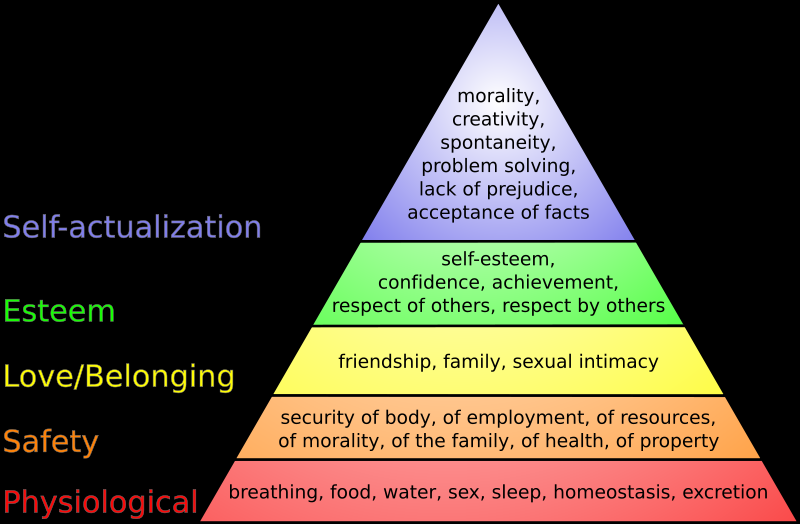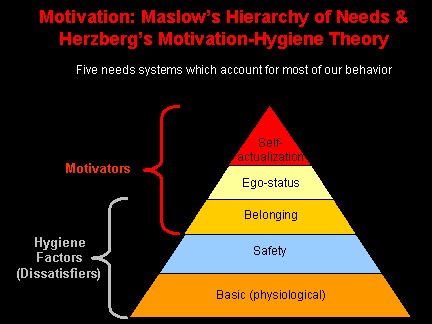
MOTIVATION THEORIES.
Maslow’s Hierarchy Of Needs
Maslow’s theory is the most widely discussed theory of motivation. It was first introduced in the book "Motivation and Personality" published in 1954. The theory can be summarized as thus: human beings have wants and desires which influence their behavior; only unsatisfied needs can influence behavior, satisfied needs cannot.
Since needs are numerous, they are arranged in order of importance, from the basic to the complex. The person advances to the next level of needs only after the lower level need is at least minimally satisfied.
Maslow’s Hierarchy of Needs
The further the progress up the hierarchy, the more individuality, humanity and psychological health a person will show.
The needs, listed from basic (lowest, earliest) to most complex (highest, latest) are as follows:
Physiological needs
Needs connected with safety and security
Social needs connected with the problems of interpersonal relations
Needs connected with esteem
Self-actualization

Illustration 1. Maslow’s Hierarchy of Needs
Maslow postulated, basing on his observations as a humanistic psychologist, that different people recognize and satisfy the needs in generally the same way. He also theorized that a person could not recognize or pursue the next higher need in the hierarchy until he or she has satisfied his current need.
Herzberg’s Motivating Factors Theory
In the January-February 1968 issue of the Harvard Business Review Frederick Herzberg, a contemporary of Maslow, published his classic article “One More Time: How Do You Motivate Employees?”
In that article Dr. Herzberg identified two types of motivational factors: factors that prevent dissatisfaction on the job and factors that enhance satisfaction.
His study suggested that the factors resulting in job satisfaction were different from the factors that lead to job dissatisfaction.
Herzberg differentiated two factors affecting people's attitudes about work: hygiene factors (dissatisfiers) and motivators (satisfiers).
H e
concluded that such factors as company policy, supervision,
interpersonal relations, working conditions, and salary are hygiene
factors
rather than motivators. According to the theory, the absence of
hygiene factors can create job dissatisfaction, but their presence
does not motivate or create satisfaction.
e
concluded that such factors as company policy, supervision,
interpersonal relations, working conditions, and salary are hygiene
factors
rather than motivators. According to the theory, the absence of
hygiene factors can create job dissatisfaction, but their presence
does not motivate or create satisfaction.
In contrast, his data showed that the motivators were elements that enriched a person's job.
He found five factors in particular that were strong determiners of job satisfaction: achievement, recognition, the work itself, responsibility, and advancement.
These motivators (satisfiers) were associated with long-term positive effects in job performance while the hygiene factors (dissatisfiers) consistently produced only short-term changes in job attitudes and performance, which quickly fell back to its previous level.
Shortly speaking, satisfiers describe a person's relationship with what she or he does. Dissatisfiers, on the other hand, deal with a person' relationship to the context or environment in which she or he performs the job. The satisfiers relate to the character of the work while the dissatisfiers relate to the working conditions.
The research shows that if as a manager you want to motivate workers to do their best you must go beyond just preventing dissatisfaction and actively promote satisfaction on the job.
Theory X And Theory y (d. Mc Gregor)
Theory X and theory Y are theories of human motivation created and developed by Douglas McGregor at the MIT Sloan School of Management in the 1960s that have been used in human resource management, organizational behavior, and organizational development. They describe two very different attitudes toward workforce motivation.
McGregor felt that companies followed either one or the other approach:
